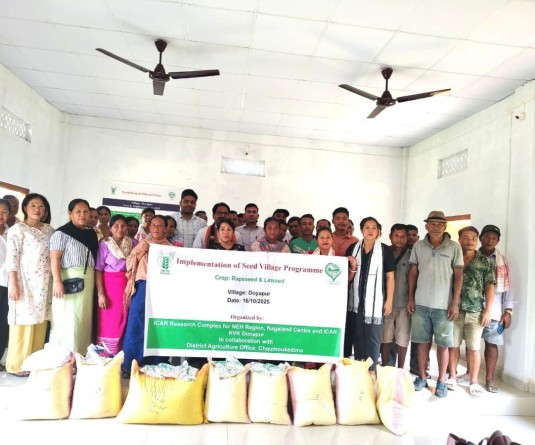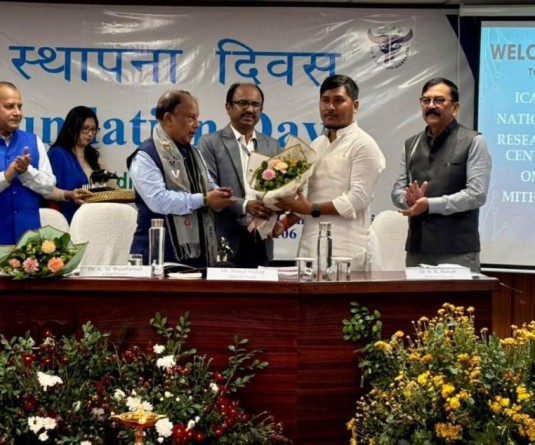
Hannah Krujia Asangla
CTO – Agronomy, KVK Phek
Sustainable agriculture is a farming approach that focuses on meeting current food and fiber needs while preserving resources for future generations. It integrates environmental health, economic profitability, and social responsibility to ensure long term agricultural productivity. The concept promotes stable and continuous production, with enough resources in the future. The five principles of sustainable agriculture outlined by FAO are:
- Boost food chain productivity.
- Protect and spare the environmental resources.
- Improve people’s wellbeing and economic growth.
- Foster ecosystems and communities resilience.
- Support with governmental initiatives and regulations.
The shift from conventional to sustainable farming
Conventional farming has been the backbone of our food production for ages. However, in our rush to meet the global food demands, we have often turned a blind eye to the environmental degradation caused by conventional agriculture practices. The intensive use of chemical fertilizers, monocultures, and the prioritization of short term gains have endangered natural ecosystems and the quality of life for both human and the ecosystem at large.

Sustainable agriculture practices offer numerous of benefits:
- Preserving soil health: Sustainable farming practices like crop rotations, cover crops, and the incorporation of organic matter into the soil ensure it remains fertile and productive.
- Promoting biodiversity: These practices create a harmonious environment where various crops and livestock can thrive. Agro biodiversity ensures a balanced ecosystem, reducing the risks of diseases and pests.
- Securing future food supply: With an ever increasing global population, securing our food supply for future generations is critical. Sustainable farming systems focus on long term productivity rather than just immediate yields.
- Supporting farmer livelihoods: The transition to sustainable practices often results in reduced input costs and better farm gate prices, directly benefiting farmers economic well being.
- Combating climate change: Sustainable farms play a pivotal role in sequestering carbon, reducing greenhouse gas emissions, and countering the adverse effects of climate change.

The 4 R’s of Sustainability
- REDUCE– Minimize resource use (e.g., water, chemicals, energy) by optimizing farming techniques such as precision agriculture and conservation tillage.
- REUSE – Utilize agricultural waste or byproducts, such as composting crop residues, recycling irrigation water, or repurposing manure as organic fertilizer.
- RECYCLE – Implement closed loop systems where organic matter and nutrients are cycled back into the soil, such as through crop rotation, cover cropping, and integrated livestock systems.
- RESTORE – Enhance soil health and biodiversity by practices like agroforestry, regenerative farming, and habitat restoration to rebuild degraded ecosystems.

Sustainable agriculture practices
1. Crop rotation and diversification - This age old practice involves growing different types of crops in a sequence on the same land. It breaks the pest cycle and increases the soil moisture and fertility.
Example: After growing crops like maize, wheat, a nitrogen fixing legume like beans can be planted to restore the soil’s balance.
2. Organic farming - Organic farming is an ecologically sustainable agricultural method that avoids synthetic fertilizers, pesticides, and genetically modified organisms (GMOs). Instead, it focuses on natural inputs and biological processes to maintain soil health, biodiversity, and ecological balance.
Example: The replacement of synthetic fertilizers with compost, manure, and bio-fertilizers.
3. Conservation tillage - Conservation tillage is a sustainable farming practice that reduces soil disturbance while maintaining crop residues on the field. It helps prevent soil erosion, improves water retention, enhances soil fertility, and reduces greenhouse gas emissions. Example: Seeds are planted directly into the soil without plowing, preserving soil structure and moisture.
4. Agroforestry - Agroforestry is a sustainable land management approach that combines agriculture, livestock production, and forestry to create a multifunctional system. By integrating trees or shrubs with crops or pastureland, agroforestry offers numerous benefits, such as improving soil health, enhancing biodiversity, increasing resilience to climate change, and providing additional income sources for farmers.
Example: Growing shade tolerant crops like mushrooms, coffee, or medicinal plants under a tree canopy, maximizing land use and promoting biodiversity.
5. Sustainable livestock farming - Sustainable livestock farming is an eco-friendly approach to raising animals that balances productivity with environmental responsibility, animal welfare, and economic viability. It focuses on reducing environmental impact while ensuring ethical and efficient animal husbandry.
Example: Grazing cattle on rotational pastures, allowing lands to recover, leading to healthier soil and reduced methane emissions.
6. Cover cropping - Growing specific crops that are not intended for harvest but protects the soil, improves soil health and fertility, and manages pests.
Example: Planting legume crops in between maize, fixes nitrogen in the soil, prevents soil erosion, suppresses weeds, and enriches the ground with essential nutrients.
7. Biological pest control - Utilizing natural systems of predators and organisms to control pests, this approach reduces the dependency on chemical pesticides.
Example: Releasing ladybugs to combat aphid populations in vegetable gardens.
8. No-till farming - This method involves planting new crops without disturbing the soil through tilling, preserving soil structure and organic matter.
Example: Directly sowing maize, and pea seeds into unplowed soil, maintaining its natural layers and organisms.
9. Permaculture - Permaculture is an integrated design that mimics natural ecosystems to create sustainable, self sufficient environment. It is based on three core ethics: care for the earth, care for people, and fair share
Example: Designing a garden where water from a fish pond is used to irrigate plants, and plant waste, in turn, feeds the fish.
10. Aquaponics - A sustainable system combining conventional aquaculture with hydroponics, fish and plants grow together in one integrated environment.
Example: Fish waste provides an organic nutrient source for plants, and the plants help filter and purify the water, which is then recirculated back to the fish tanks.
11. Agrobiodiversity - This emphasizes the importance of genetic variety in plants and animals to ensure resilience against diseases, pests, and climate change.
Example: Cultivating multiple rice varieties to safeguard against potential diseases that could wipe out a single strain.
12. Water management - Efficient water use and storage practices ensure water conservation and optimal usage.
Example: Implementing drip irrigation systems that provide water directly to plant roots, reducing evaporation and conserving water.
13. Waste recycling and composting - Turning organic waste into valuable compost, this process enriches the soil, reduces the need for chemical fertilizers, and minimizes waste.
Example: Using vegetable scraps, fallen leaves, and manure to create a rich compost heap that can be returned to the garden.
14. Polyculture - Growing multiple crops in the same space simultaneously, this method maximizes land usage, reduces pest issues, and promotes a balanced ecosystem.
Example: Growing beans, corn, and squash together. While beans fix nitrogen in the soil, corn provides a structure for beans to climb, and squash acts as a ground cover, reducing weed growth.

References:
https://regenx.ag/blog/sustainable-agriculture-practices
https://permaculturaviva.info/permaculture-ethics-and -know-how-they-guide-sustainable-living










